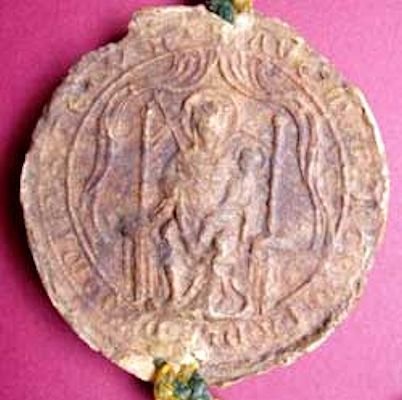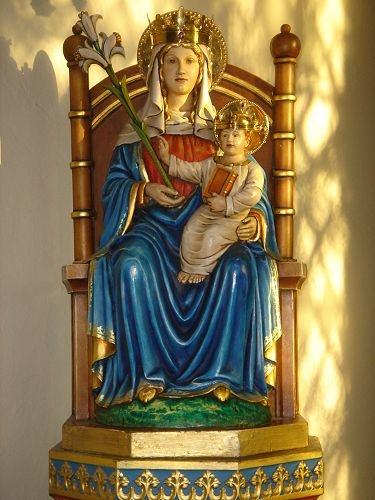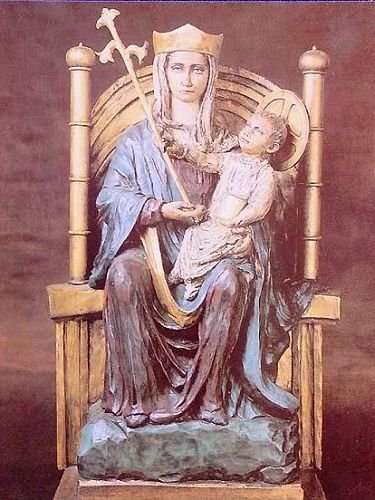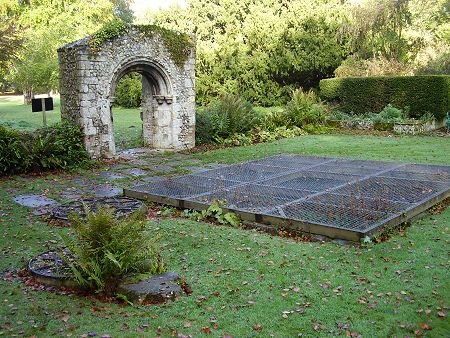Walsingham, Norfolk
England’s Nazareth, Our Lady of Walsingham
Walsingham village lies near Wells-next-the-Sea in Norfolk County. The shrine has two parts, a Catholic and an Anglican one, and three Madonnas, a Catholic, Anglican, and Orthodox. For the complete daily schedule of liturgies, including processions and sprinkling with holy water from the healing well, visit the Anglican site and the Catholic site Original Madonna and shrine from the 11th century destroyed in 1539. One part of it, the Slipper Chapel, was rebuilt in 1896 by a Catholic lady and received a wooden statue from Oberammergau, Germany. Apparently it is rather small and insignificant looking, so a second statue was commissioned to replace the first, this one bigger and carved in stone by the Canadian artist Marcel Barbeau. The Holy House, the main part of the shrine, was rebuilt by the Anglican Church in 1921 and received a stone statue. Besides the small Catholic Slipper Chapel, there is a larger, modern Catholic church on the premises. In it hangs the Orthodox icon, which was commissioned in 1984 by the local Catholic priest as a call to Cristian unity and painted by Archimandrite David, a member of the Russian Orthodox community of St. Seraphim, Walsingham. Their tiny church is located at 63A High Street, Little Walsingham.
The Orthodox Icon
The Seal of Walsingham Abbey
The Catholic Statue
The Anglican Statue
Although Our Lady of Walsingham is not generally referred to as a Black Madonna and her modern reincarnations look rather pale, I am listing her in this index for the following reasons:
She is listed in Ean Begg’s index of Black Madonnas.
She was cursed as a “counterfeit Ephesian Diana” in the 14th Elizabethan Homily (anti-Catholic homilies, which Queen Elizabeth I ordered to be read all over her kingdom, shortly after the reformation). That is to say, she was compared to perhaps the most famous black goddess, Artemis of Ephesus – a good indication that the original statue probably was considered a Black Madonna.¹
She is listed in Peter Mullen’s “Shrines of Our Lady: a Guide to Fifty of the World’s Most Famous Marian Shrines”, and hers is the National Shrine of English Catholics.
She is also listed in Roy Abraham Varghese’s “God-Sent: a History of the Accredited Apparitions of Mary”.
A nice English lady, Hillary Ratnasabapathy, recommended her to me for inclusion in this index. Thanks Hillary!
The Legend
The story of Walsingham begins in 1061 A.D. with a good and pious young widow, the Saxon Lady of the Manor of Walsingham Parva by name of Richeldis de Faverches. The oldest record we have of the ensuing events is the text of the “Pynson Ballad" from around A.D. 1485. It describes Richeldis praying to the Virgin Mary and saying: “I want to undertake some special work in your honor. Please tell me what it should be.” In response, the Virgin Mary appears to her, some say in dreams, others in apparitions. In any case, three times the Queen of Heaven leads her in spirit to Nazareth and shows her the house where the Annunciation of the birth of Jesus occurred (known in the Catholic world as the Holy House of Mary). There Mary asks Richeldis to memorize the measurements exactly and to build a replica in Walsingham. Here are some excerpts: (my version of the medieval English ballad, part transcription, part summary and paraphrasing.)
Mary to Richeldis: “Lo daughter, consider, of this place take surely the measure, another like this at Walsingham set, to my laude and singular honor. All that seek me there shall find succor. There they shall experience in a memorial the great joy of my salutation.² First of my joys, the original ground, root of mankind’s gracious redemption, when Gabriel told me that I was to be a mother through humility, and God’s son conceive in virginity.” (…)
Having received these visions and instructions, the question arose as to where exactly this replica of the Holy House should be built. The Blessed Virgin gave a sign: Richeldis was shown a meadow wet with “celestial drops and silver dew sent down from on high”, except for two places in the meadow, equal in shape and size, which were completely dry. Poor Richeldis had a hard time picking one of them, but settled on the one close to two wells. She hired the wisest carpenters to begin with the work, but they couldn’t get anything right. No two pieces would fit together correctly, no matter how much they agonized over this project. Finally they gave up and demanded of their mistress Richeldis that she ask the Madonna for more guidance. As the men went to bed and slept, the lady of the manor prayed fervently all night to Mary for help. So the Blessed Mother took the role of chief builder. She directed angels in the construction and had them move the building to the other location, a little more than 200 feet away.
Early next morning, the menfolk came back to their work place only to find everything finished perfectly. There was nothing left for them to do, so they went home. Immediately an endless stream of pilgrims began to flow to Walsingham.
For hundreds of years, miracles never ceased, more than the chronicles could contain or witness to. Lame were made whole, blind to see, sailors who prayed to Our Lady of Walsingham were saved from tempests, deaf could hear, people wounded in body, mind, or soul were healed, lepers cleansed, wicked people converted.
“Oh England, (the ballad concludes) you have great cause to be glad, comparable to the Promised Land is the grace you attained through this glorious Lady’s support. In every realm and region you have long been called the Holy Land, Our Lady’s dowry. For in you was built New Nazareth, a mansion to the honor of the heavenly empress and her most glorious salutation, chief principal and ground of our salvation. Gabriel said: ‘Ave’ in Old Nazareth; may we here remember that joy daily! ”
Two Equal Shapes
The second site Mary marked with her miracle dew was not forgotten. Another chapel, dedicated to St. Lawrence, was erected there and the wells became known for their healing properties.
What could the two spots of equal size and shape mean? Is it possible that Mary foresaw the simultaneous existence of two shrines in Walsingham, one Catholic and one Anglican, and wanted to make clear that she blessed them both, even though only one was the right spot for her Holy House?! I think so. Someone else guessed the Madonna was just being a trickster and playing games with Richeldis.³ I believe she had a very serious concern she could only express through symbols and hope someone might catch on. If she had gotten too explicit, she would have been branded as an apparition of the Devil. This incident reminds me of Mary’s apparition in Paris in 1830, when she gave the world the “Miraculous Medal” On one side it bears the following symbol: Mary’s letter M with the cross of Christ anchored in it, underneath are the hearts of Mary and Jesus next to each other, equal in size. Mary explained the symbol on the opposite side, but of this one she only said: “The M and the two hearts say enough.”⁴ Seems to me, the image says loud and clear: “Mary and Jesus are inseparable and equal”, but that’s not something one is allowed to say in the Catholic Church, much less in Protestant Churches.
Similarly, the two equal shapes Mary drew may have been a promise she couldn’t voice in words at the time, namely that she was going to bless equally her children in both the Catholic and the Anglican shrines in Walsingham and in the Catholic and the Anglican Churches as a whole.
Walsingham: Mary’s Attempt to Avoid War?
I believe the whole Walsingham project had a lot to do with the effort to bring peace to a world of religious wars and to help Europe cope with the eventual loss of control of the Holy Land in Palestine.
Though some people have questioned 1061 as the building year of the Holy House in Walsingham, there is much more evidence to support than to contradict it.⁵ That means it was built before the Crusades and before the actual Holy House of Mary was moved from Nazareth to Loreto, Italy, brick by brick. In order to explain why Mary asked for this construction, we have to look at the historical context.
All through the Middle Ages, people undertook pilgrimages to holy places, because the Church taught that this would secure their place in heaven and save them from hell. Until Muslims conquered Palestine and made Christian pilgrimages to the Holy Land increasingly dangerous and finally impossible, it had been considered the most important and effective place for obtaining salvation. Muslims not only interfered with a major Christian way to heaven, they also began destroying many Christian shrines in Palestine. All this was plenty of reason to start the Crusades. At Richeldis’ time the tension was building steadily.
I don’t find it implausible that Mary, in order to try and prevent war, would inspire Christians to bring parts of the Holy Land to Europe and to learn that with God’s grace any place can become holy. I do not think she wanted her children to kill each other over who controls Palestine! To this day, Our Lady speaks up for peace between denominations and religions. E.g. in her apparitions in Medjugorje, in the middle of a bloody religious civil war, she said: “Muslims, Orthodox, Catholics, … you are all my children. … all humans are equal before God.”⁶ She even pointed out a Muslim woman, a neighbor of her Catholic visionary, saying: “She is a true believer, a saintly woman. You should try to be more like her...."⁷
The Walsingham message is clear: the Holy Land is here! No need to travel so far away! It is written into its ballads and customs. As the Pynson Ballad says about the shrine: “comparable to the Promised Land is the grace you attained through this glorious Lady’s (Mary’s) support. In every realm and region you have long been called the Holy Land.” Another ballad, called the Ralegh ballad asks: “As you came from the holy land of Walsinghame, met you not with my true love (Mary) by the way as you came?”
The Slipper Chapel , detail of photo by: Ashley Dace
To make it really clear how holy the ground in and around Walsingham was, the custom developed to remove ones shoes one mile before reaching the Holy House. This was in imitation of God’s command to Moses on Horeb (i.e. Sinai), the mountain of God, in Exodus 3:5: "Take off your sandals, for the place where you are standing is holy ground." Interestingly, it was also in unspoken imitation of the Muslims, who take their shoes off when entering any mosque. People usually learn something from their enemies and it is not unlike Mary to point out some benefits of Muslim spirituality to her Catholic children.
In 1325, a so called Slipper Chapel was built in the neighboring village Houghton St Giles, at the place where one left ones shoes to walk the last “holy mile” barefoot or in slippers provided at the chapel. To make more links to the Holy Land and the Mountain of God, this chapel was dedicated to Saint Catherine of Alexandria, whose tomb is on Mount Sinai and who is the patron saint of pilgrims to the Holy Land in Palestine.
All too slowly the Church embraced Mary’s message. Gradually it declared more and more holy ground in Europe. The graves of the Apostles Peter and Paul in Rome had always been important. However, only in Richeldis’ time, Santiago de Compostella, the resting place of St. James, the brother of Jesus, began to be regarded as a holy place powerful enough to grant a pilgrim “plenary indulgence”, i.e. the forgiveness of all his or her sins.⁸ All those places were still out of reach for the common folk of Britain and Northern Europe, so Walsingham was an eternal lifesaver for many.
Further History
In 1226 the Walsingham shrine received the royal patronage of Henry III. All along the road leading to it were built chapels and refreshment houses, much like on the Way to Santiago de Compostella. After that, 6 more kings and one queen came as pilgrims, along with countless others of all walks of life.
It seems to me that Walsingham prepared the way for Loreto. After building a replica of Mary's House in Europe had proven to be an enormous success and the original in Palestine was threatened by destruction, the actual Holy House was transported brick by brick to Loreto, Italy in 1291. With that, the English shrine must have lost many pilgrims from the continent, but it didn’t begrudge Italy its gain of the actual House of Mary. On the contrary, a copy of the Black Madonna of Loreto was also venerated in Walsingham.⁹
In 1538, four years after Britain had broken away from the Catholic Church, the shrine in Walsingham was destroyed and its Madonna transported to London to be burnt. This was done by the orders of King Henry VIII, even though both he and his first of six wives had gone there on pilgrimage. His second wife, Anne Boleyn, intended to go, but he had her executed before she could realize her intention. Only the Slipper Chapel survived the Reformation, though it was desecrated and used consecutively as a poor house, a forge, a cowshed and a barn.
The interior of Fr. Patten's Holy House with the Madonna crowned and robed
Things looked dismal for three centuries. But in 1829 freedom of religion was restored to British Catholics and their ancient forms of worship enjoyed a resurgence. Even in the Anglican Church a certain return to ancient ways was suddenly advocated by the so called Oxford Movement.
In 1896, a modern kind of miracle happened. 41 km (25 miles) from Walsingham lies a town called King’s Lynn where some Catholics remained. They remembered the old Holy House, but had no hope of it being reconstructed in Walsingham. So they decided to build a copy of it in their own town. They even had a Lady of Walsingham statue carved and blessed by the Pope. This inspired Charlotte Boyd, a rich Anglican lady, to buy and restore the original Slipper Chapel. In the process she converted to Catholicism and ended up giving the shrine to the Benedictine order of Catholic monks.¹⁰
In 1922, all this in turn inspired the Anglican priest Fr. Hope Patten, the vicar of Walsingham, to rebuild the original Holy House. To do so he had to overcome much opposition from his superiors. With great perseverance he completed the task, this time in brick and stone, in accordance with Mary’s original house in Nazareth, that now stands in Loreto.¹¹ Father Patten had a stone statue carved modeled after the seal of the former abbey of Walsingham and saw to it that prayers and rosaries would be recited before it every night.
Photo: Matthew Champion
The Anglican website adds this: “We are told that the original sign to Lady Richeldis as to the exact position she was to build the Holy House was the springing up of water from the ground. Fr Patten was thrilled when, as the foundations of the Shrine Church was being dug in 1931, the workman uncovered an old disused well. Cleaned out and repaired, the well has gushed wonderful water for more than 75 years. (…) After listening to a short address and prayers, the pilgrims make their way to the well where they receive a sip of the water, are signed with the cross on their foreheads and then have water poured through their hands.”
On the Feast of the Assumption, 15 August 1934, the Catholic Bishop of Northampton celebrated the first public mass in the Slipper Chapel in four hundred years. Two days later, Cardinal Francis Bourne led a national pilgrimage of the Catholic bishops of England and Wales and more than 10,000 faithful to the shrine. From this date forward, it became England’s Catholic National Shrine.
Twenty years later on 15 August 1954, the (Black?) Madonna of Walsingham was canonically crowned, with a crown funded by female devotees. Moments after the coronation ceremony, two white doves descended on the lap of the image, which was considered miraculous. The ceremony was accompanied by both British and American airmen, who sponsored the security for the event, and devotees who walked barefoot in the "Holy Mile" leading into the shrine.¹²
With Vatican II in the early 1960’s, came an opening in the Christian world to interfaith and ecumenical dialogue. In Walsingham old rivals became friends and collaborators. As the Catholic website says: "Unity between all Christians is the constant prayer of the Shrines in Walsingham."¹³ Nonetheless, when the statue of the Madonna is carried in procession through the village, it still irritates some Protestants. Especially some evangelical Christians can get quite vocal about their disagreements. May they too receive plenary indulgence one day!
How Many Holy Wells?
As so often with shrines that are many centuries old, there are conflicting legends and claims. The Pynson Ballad speaks of two wells near but not under the Holy House and of dry shapes in a wet meadow pointing to the location for its building. Fr. Patten and the Anglican Church mention a healing well marking the very spot of Mary’s House.
Matthew Champion published an excellent photo essay entitled “A Walsingham Pilgrimage” in ‘Peregrinations’, the online journal of the International Society for the Study of Pilgrimage Art. Here is his photo of the two wells mentioned in the Pynson Ballad and what he has to say about them: “In the foreground can be seen the two Holy Wells of Walsingham. These ancient wells have been venerated for over two thousand years and have produced evidence of ritual deposition that pre-dates the Roman occupation of England. It is perhaps the presence of these wells that prompted the erection of the original Holy House only a few dozen yards away. Between the two wells used to sit a stone that worshipers were required to kneel upon. They then dipped a hand in each well and silently asked for their boon. (...)
The ‘new’ Holy Well within the Anglican shrine was ‘rediscovered’ during the excavations undertaken in the 1930s prior to the building of the new shrine. Father Hope Patten maintained that this was the original Holy Well of Walsingham – a belief shared by the many hundreds of thousands of modern pilgrims who carry its waters away with them. However, more recent scholarship suggests that the well belonged to either the ‘white hart’ or ‘maidenhead’ hostelries, or the Priory’s Almonry, that once stood upon the site. Prior to excavation, the well had been filled in with all sorts of medieval and post-medieval rubbish.”
Either way, a typical Black Madonna comes with a sacred source of water and/or a sacred stone and often chooses a place that has been sacred since before the Christian era. It’s nice to know that Our Lady of Walsingham shares these characteristics.
Matthew Champion goes on to question not only Patten’s holy well, but also the location of the Holy House: “Excavations in the well garden in the early 1960s revealed a small Romanesque chapel within which stood the wooden structure of the Holy House, not where it is now.”
Wherever exactly the original holy wells and holy house used to be, let’s remember the spirit of Our Lady’s message: holy ground and holy wells can be everywhere, wherever you find them by the grace of God. They are created by a collaboration between divine grace and the faith of the people. By the grace of God even the most mundane well becomes holy when hundreds of thousands of faithful treat it as such.
Footnotes:
1. See: Dominic James and Gary Waller, “Walsingham in Literature and Culture from the Middle Ages to Modernity”, Ashgate Publishing Co., 1988: p. 80)
2. Some translate the medieval word spelling “salutacyon” as ‘salvation’, but if you read the whole ballad it becomes clear that salutation refers to the angel Gabriel’s greeting in Luke 1:28 of Mary: “Hail, full of grace, the Lord is with thee”
3. Walsingham in Literature and Culture, op. cit. p.6
4. Roy Abraham Varghese, “God-Sent: a History of the Accredited Apparitions of Mary”, the Crossroad Publishing Co., New York: 2000, p. 95
5. See: https://en.wikipedia.org/wiki/Our_Lady_of_Walsingham
6. Visit: www.Medjugorje.org and look up Mary’s message on Oct. 1, 1981 or go to the thesaurus on that site and scroll down to the key word “Muslims”.
7. Mary Craig, "Spark from Heaven: Mystery of the Madonna of Medjugorje", 1988, on: http://www.duversity.org/The%20Day%20of%20Mary.pdf This website is an amazing collection of Mary’s attempts in the course of centuries, to bring peace between religions, especially Christianity and Islam.
8. https://en.wikipedia.org/wiki/Camino_de_Santiago
9. Ean Begg, "The Cult of the Black Virgin", Penguin Books, London: 1985, p. 165
10. Walsingham in Literature and Culture, op. cit., p. 11
11. Peter Mullen, “Shrines of Our Lady: a Guide to Fifty of the World’s Most Famous Marian Shrines”, St. Martin’s Press, New York: 1998, p.64
12. https://en.wikipedia.org/wiki/Basilica_of_Our_Lady_of_Walsingham










